employee
Moscow, Moscow, Russian Federation
CSCSTI 77.29
The article discusses the issues of identifying the key markers for evaluating the preparation of swimmers aged 7-9 years at the initial stage of sports training. The purpose of the study is to identify markers that allow for assessing the level of preparedness of children at the initial stage of swimming education during the process of sports orientation. Research methods and organization. The study utilized an analysis of specialized literature, surveys of leading coaches and experts in the field of swimming, as well as the implementation of a pedagogical experiment. This enabled the identification of the most informative physiological, psychophysiological, and pedagogical criteria for evaluation. Research results. Among the psychophysiological indicators, the following most informative markers have been identified: the strength of the nervous system, lability, mobility, the balance of nervous processes, and the type of leading sensory system. There is a weak correlation between the mobility of the nervous system and coordination abilities; however, no significant differences were established by the third year. The balance of nervous processes has a significant influence on the speed of motor skill formation, proprioceptive sensitivity, and coordination abilities. Conclusions. The most informative tests have been established, which should be used for a comprehensive assessment of children's preparedness at the initial stage of sports training in swimming. With the help of a comprehensive assessment of the athlete's current preparedness, the coach will be able to approach the structuring of the training process more effectively, without losing the motivation and interest of the child.
competitive swimming, initial sports training, individual approach, comprehensive testing, assessment of athlete readiness
1. Davydov V. Yu., Lushchik I. V., Shmareva E. A. (2012), “Using psychophysiological parameters of the central nervous system activity taking into account the type of constitution of primary school students for their selection for competitive swimming”, Physical education and sports training, No. 1 (3), pp. 137–145.
2. Bulgakova N. Zh. [et al.] (1993), “Age dynamics of morphological, strength and functional indicators that limit the sports achievements of swimmers aged 11-18 as a basis for building long-term training and selection”, Tr. scientist GTSOLIFKa. 75 years, Yearbook, Moscow, pp. 242–252.
3. Korolevich A. N., Davydov V. Yu., Petryaev A. V., Sinitsin A. S. (2015), “Relationship between swimming speed and power, morphofunctional, psychophysiological indicators in swimming”, News of the Tula State University. Physical Culture. Sports, No 1, pp. 48–57.
4. Solomatin V. R., Bulgakova N. Zh. (2014), “Accounting for the laws of age development in sports selection and long-term training of young swimmers”, Olymp. bul., Moscow, No. 15, pp. 167–174.
5. Sagaydak S. S. (2004), “Psychophysiological characteristics and performance in high-performance sports”, Scientific substantiation of physical education, sports training and preparation of personnel in physical culture and sports, Proceedings of the 7th Intern. scientific session of BSUPC and NIIPhKiS RB on the results of scientific research work for 2003, Minsk, April 6-8, 2004, Belarusian State University of Physical Culture, Minsk, pp. 120–121.






